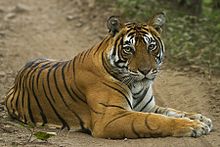Ranthambhore National Park
History
Ranthambore National Park was established as the Sawai Madhopur Game Sanctuary in 1955, initially covering an area of 282 km (109 sq mi). It was declared one of the Project Tiger reserves in 1974.
Features

Ranthambore National Park covers a total area of 392 km (151 sq mi), including buffer zone. It harbours dry deciduous forests and open grassy meadow. The core area is about 275 km (106 sq mi). Ranthambore Tiger Reserve spreads over an area of 1,334 km (515 sq mi) at an elevation range of about 215–505 m (705–1,657 ft).
Ranthambore Fort was built in the 10th century by Chauhan rulers at 210 m (700 ft) above the surrounding plain. Inside the fort are three red stone temples devoted to Ganesh, Shiva and Ramlalaji. There is a Digamber Jain temple of Sumatinatha and Sambhavanatha. The temples were constructed in the 12th and 13th centuries. Padam Talao is the largest of the many lakes in the park. A red sandstone Jogi Mahal is at the edge of the lake.
Flora
There are over 300 species of trees, including over 100 of medicinal importance. The land features dense tropical dry forest, open bushland and rocky terrain interspersed with lakes and streams. The ecoregion includes Khathiar-Gir dry deciduous forests.
Fauna

Ranthambore National Park hosts over 270 species of birds, including crested serpent eagle, painted francolin and Indian paradise flycatcher.
Tigers

Ranthambore is known for its Bengal tiger population. During the past few years, there has been a decline in numbers due to poaching and other reasons. The number of tigers was 25 in 2005 and 48 in 2013. As of 2022, there were 80 tigers in the park.
Ecosystem valuation
Economic valuation of the tiger reserve estimated that its flow benefits are worth 8.3 billion rupees (0.56 lakh/hectare) annually. Gene-pool protection services (7.11 billion), provisioning of water to the neighbouring region (115 million) and provisioning of habitat and refuge for wildlife (182 million) were some of the important services that emanated from the tiger reserve. Other services included nutrient cycling (34 million) and sequestration of carbon (69 million).
See also
References
- ^ Riley, L. (2005). Nature's strongholds : the world's greatest wildlife reserves. Princeton, USA: Princeton University Press. p. 225. ISBN 9780691122199.
- ^ Derr, P. G. (2003). Case studies in environmental ethics. Maryland, USA: Rowman & Littlefield. p. 17. ISBN 0742531376.
- ^ "Kathiarbar-Gir Dry Deciduous Forests". Terrestrial Ecoregions. World Wildlife Fund. Retrieved 14 February 2017.
- ^ Sadhu, A.; Jayam, P. P. C.; Qureshi, Q.; Shekhawat, R. S.; Sharma, S.; Jhala, Y. V. (2017). "Demography of a small, isolated tiger (Panthera tigris tigris) population in a semi-arid region of western India". BMC Zoology. 2: 16. doi:10.1186/s40850-017-0025-y.
- ^ "24 Tigers 2013 will be shifted from Ranthambhore". Patrika Group (in Hindi). Retrieved 7 July 2014.
- ^ "Two more cubs spotted in Ranthambore". The Times of India. 2014. Retrieved 7 July 2014.
- ^ "Economic Valuation of Tiger Reservers in India – A value+ approach" (PDF). Archived from the original (PDF) on 26 August 2016. Retrieved 14 August 2016.
Further reading
- Singh, V.; Shrivastava, A. 2007. Biodiversity of Ranthambhore Tiger Reserve, Rajasthan. Scientific Publishers, Jodhpur. ISBN 81-7233-492-3.